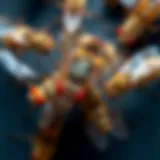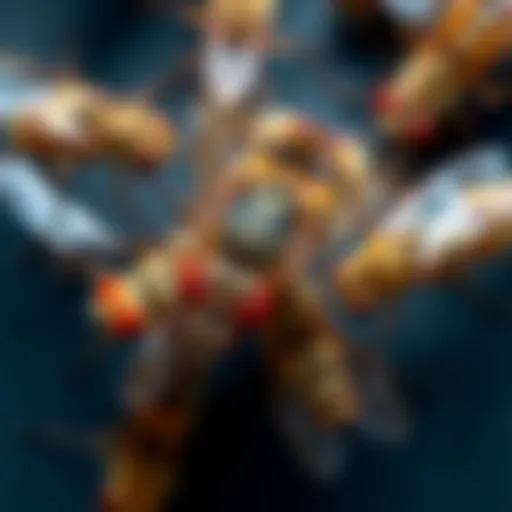Comprehensive Guide to Effective Wasp Nest Elimination
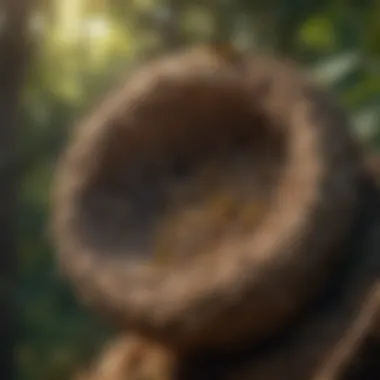

Intro
Wasp infestation is a common concern for many households. Understanding the behavior and characteristics of these pests is crucial for effective elimination. By recognizing the signs and locations of wasp nests, homeowners can take appropriate action. This guide will provide detailed information on pest identification, prevention methods, and do-it-yourself pest control solutions. Each part of the guide aims to empower readers with the knowledge they need for effective wasp nest management.
Pest Identification
Common Household Pests
Wasp nests can often be found around residential areas, particularly in eaves, trees, or hidden corners. Common types of wasps include yellow jackets, paper wasps, and hornets. Yellow jackets are small, have black and yellow stripes, and are often aggressive. Paper wasps are larger, with elongated bodies and a more slender appearance. Hornets, on the other hand, are bigger with a robust structure, and can be quite territorial.
Signs of Infestation
Identifying a wasp infestation early is key. Look for:
- Frequent sightings of wasps around your home.
- Nests in sheltered areas, especially during warmer months.
- A noticeable increase in wasp activity when food sources are available, such as open trash or outdoor dining areas.
- Piles of dead wasps or scattered remnants near potential nest sites.
A proactive approach can save both time and money when dealing with wasp control.
Prevention Methods
Prevention is often the best strategy against wasp infestations. Implementing effective environmental modifications can significantly reduce wasp activity.
Environmental Modifications
Consider the following changes:
- Maintain cleanliness in outdoor eating areas, covering food and disposing of waste properly.
- Seal any cracks and crevices around your home to deny entry.
- Keep compost piles covered and reduce enticing scents.
Home Maintenance Tips
Proper home maintenance can deter wasps from settling:
- Regularly inspect and maintain gutters, ensuring no stagnant water is present.
- Trim back foliage and bushes that provide nesting areas.
- Install screens on windows and doors to prevent entry.
DIY Pest Control Solutions
When it comes to dealing with wasp nests, several do-it-yourself options exist to effectively control and eliminate these pests.
Natural Remedies
Some natural remedies to consider include:
- Mixing soap and water in a spray bottle can suffocate wasps.
- Apple cider vinegar traps can attract and capture wasps.
DIY Traps and Barriers
Creating traps and barriers can also be effective. Here’s a simple trap:
- Cut a plastic bottle in half.
- Invert the top half into the bottom half, creating a funnel.
- Add sugar water or fruit juice as bait.
Using barriers like mesh or netting in outdoor areas can help protect against wasps.
With the right knowledge and strategies, homeowners can effectively manage wasp nests. Each section of this guide focuses on empowering you to handle this pest problem at home.
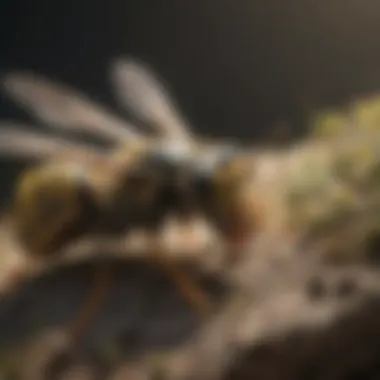

Understanding Wasps
Understanding wasps is a vital component of effective wasp nest elimination. Knowledge of their behavior, habitats, and species types allows homeowners to react appropriately to wasp activity. Ignoring these elements can lead to poorly timed or ineffective removal efforts, potentially resulting in increased aggression from these insects.
Wasp Species Overview
There are over 30,000 species of wasps known to exist. Among the most familiar are the yellow jackets, paper wasps, and hornets. Each species has unique characteristics, which can affect nest structure and behavior. For instance, yellow jackets are known for building nests in the ground, while paper wasps typically create umbrella-shaped nests under eaves. Understanding these distinctions can guide removal strategies, ensuring that actions are tailored for specific situations.
Learning to identify various wasp types can aid in recognizing potential dangers, determining whether a nest is aggressive or relatively harmless, and devising appropriate removal methods. Productive pest management begins with accurate identification.
Wasp Behavior and Ecology
Wasps play a complex role in the ecosystem. They are predators of many garden pests, contributing to ecological balance. However, when wasps invade human spaces, their behavior can quickly become a concern. They tend to be more aggressive in the late summer, particularly when food sources are scarce. Understanding this behavior can prepare homeowners for interactions and help them form strategies for safety.
Wasps are social creatures, typically living in colonies that consist of a queen and worker wasps. Their nests can vary in size, depending on the species and the time of year. Monitoring wasp behavior provides insight into potential nest sizes and the urgency of removal, if necessary.
Signs of Wasp Activity
Being able to identify signs of wasp activity is crucial. Homeowners should be vigilant about common indicators that may suggest a nest nearby:
- Frequent buzzing sounds: A notable increase in buzzing, especially near eaves or gardens.
- Visible nests: Look for nests in sheltered areas around your home.
- Aggressive behavior: Increased aggression from wasps indicates a potential nest nearby.
If these signs are present, it is wise to take action. Knowing the signs can prevent a minor issue from becoming a significant threat, safeguarding residents and pets from possible stings.
It's essential to monitor wasp behavior frequently during late summer, when aggressive activity tends to increase.
Understanding wasps provides essential groundwork for effective management. Equipped homeowners can navigate the challenges posed by these insects, leading to safer living environments.
Identifying Wasp Nests
Identifying wasp nests is crucial for effective pest control. Understanding where these nests are located helps housewives and homeowners strategize their removal. Timing is also critical; a quick identification can mean the difference between a peaceful home and a stressful situation.
Common Nest Locations
Wasp nests can be found in numerous locations, often where they have easy access to food and shelter. Common locations include:
- Under eaves or porches: Wasps prefer shaded areas for nesting, making these spots attractive.
- In trees and shrubs: They often build nests in branches, utilizing the cover provided by foliage.
- Inside wall cavities: Some wasps, like the yellow jacket, may find their way indoors, creating nests within the walls of a house.
- Near outdoor garbage: Wasps are drawn to food sources, making proximity to unsealed garbage a prime nesting site.
Locating nests early can prevent future infestations. On occasion, nests may not be visible at first. Observing wasp activity around your home can provide insights on their nesting sites.
Types of Wasp Nests
Wasp nests vary widely based on the species. Some typical types include:
- Paper nests: Constructed from chewed wood fibers mixed with saliva, these nests have a distinctive layered appearance. Found mainly in aerial spaces, they hang down and can be quite large, with multiple combs inside.
- Ground nests: Typically made by yellow jackets, these might be shallow or deep in the ground, often concealed by grass or leaves. These nests can be aggressive and create a hazard in yards or gardens.
- Mud nests: As the name suggests, these are built from mud and can be found on buildings or under eaves. Muds nests have a more solid appearance than paper nests and are often less noticeable.
Awareness of the different types of nests can aid in choosing the right removal method. Moreover, recognizing the nest type can inform individuals about the frequency of the species and how to manage their populations effectively.
Safety Precautions
Effectively removing wasp nests requires more than just strategy; it necessitates adherence to crucial safety precautions. Wasps are often aggressive, especially when provoked, and their presence poses a risk to both individuals and pets. Understanding the protective measures to take ensures that the process is as safe as possible. Proper precautions reduce the chances of being stung and help in managing the overall process more smoothly. This section will cover necessary protective gear and important indicators for when to seek professional help.
Protective Gear
Equipping oneself with the appropriate protective gear is paramount when attempting to eliminate wasp nests. This gear serves as a barrier against potential stings and minimizes physical injuries during the removal process. Here is a brief overview of essential items to consider:
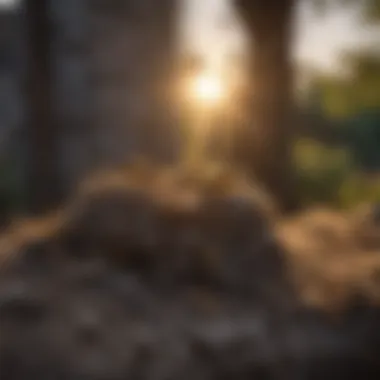

- Protective Clothing: Wear thick, long-sleeved shirts and long pants. The fabric should be tightly woven to prevent wasps from stinging through it.
- Gloves: Heavy-duty gloves prevent stings on the hands, which are particularly vulnerable.
- Headgear: A beekeeping helmet or similar protective headgear with a mesh face shield can safeguard the face and neck.
- Closed-Toe Shoes: Sturdy footwear protects your feet in case of a ground nest and minimizes injuries from obstacles.
Before starting any removal operation, ensure all gear fits well and covers as much skin as possible. Take the time to check your safety equipment for any signs of wear or damage. This precaution helps in maintaining effectiveness.
When to Seek Professional Help
While some homeowners may find it feasible to manage wasp nests themselves, certain situations necessitate the expertise of professionals. Here are criteria indicating when it might be wise to seek external help:
- Size of the Nest: If the nest is larger than a basketball, it is often too dangerous to attempt removal yourself.
- Location: Nests in high or tricky locations, such as attics, under eaves, or inside walls, can pose significant risks and are best left to experts.
- Allergies: Individuals with known allergies to wasp stings should avoid DIY methods entirely. The risk of anaphylaxis is high.
- Aggressive Behavior: If the wasps display aggressive behavior during normal activity or when approached, it may be time to call for help.
"When in doubt about your safety or the best strategy for removal, always opt for a professional. Your safety is the priority."
Methods for Wasp Nest Removal
Removing wasp nests is a critical endeavor for those aiming to maintain a safe environment around their homes. The methods for eliminating these nests require careful consideration of various elements. First, knowing the right techniques can help homeowners avoid the risk of wasp stings, which can be painful and potentially serious for those with allergies. Moreover, understanding which method to employ can have long-lasting effects on controlling wasp populations in a given area. The choice between chemical treatments, natural remedies, and physical removal techniques is often dependent on personal preferences, the size of the infestation, and environmental considerations. Below are detailed explorations of each method available for wasp nest removal.
Chemical Treatments
Chemical treatments are among the most common approaches for eliminating wasp nests. Products such as insecticides are designed specifically for this purpose. Safety is paramount when using these chemicals; hence, protective gear should be worn, including gloves, long sleeves, and goggles. It is also important to follow instructions carefully, as improper use can result in ineffective outcomes and danger to the user. Often, these treatments come in aerosol form, enabling directed application at the nest entrance during evening hours when wasps are less active.
Some active ingredients to look for include pyrethroids, which work quickly to disable wasps on contact. They also provide a lingering effect that can kill returning wasps later. However, one should be mindful of the possible dangers these chemicals pose to beneficial insects and local wildlife. For this reason, it's a good practice to explore environmentally-friendly options offered by reputable brands.
Natural Remedies
For homeowners who prefer a less invasive approach, natural remedies can be effective. There are several methods to deter or kill wasps without the use of harsh chemicals. Soap and water is a popular choice. When mixed, these two elements create a substance that, when sprayed directly on the wasps, suffocates them. This method is casual in its approach, requiring minimal risk to the user.
Another popular remedy involves peppermint oil. It has been shown to repel wasps effectively. Appliing a mixture of peppermint oil with water around potential nesting sites may prevent wasps from establishing new nests. While natural remedies can be gentler on the environment, it's essential to remain consistent and strategic in their application, as they might not eradicate existing nests as swiftly as chemical options.
Physical Removal Techniques
Physical removal techniques focus on directly taking down the nests rather than using substances to eliminate the wasps. This method requires caution, as disturbing a nest can provoke an aggressive response from the insects. Wearing protective clothing is critical. For nests that are small and easily accessible, using a long-handled tool such as a broom or a stick can effectively knock them down.
In some cases, vacuum devices are available specifically for this purpose, designed to capture wasps while simultaneously collecting their nests. When employing physical removal, ensure the area is clear of obstructions and potentially dangerous points of access. For larger nests, seeking professional assistance may be advisable, given the increased risks associated with wasp removal.
Always assess your comfort level with these methods before proceeding. Being well-informed helps in making safe and effective choices.
Post-Removal Considerations
After effectively eliminating a wasp nest, it is crucial to consider several post-removal factors. These considerations not only enhance the safety of your environment but also help in preventing future infestations. Once the immediate threat is addressed, attention shifts to maintaining a repellent surroundings and ensuring that any remnants of the nest do not attract more wasps.
Preventing Future Infestations
To prevent future infestations, understanding how and why wasps are drawn to particular locations is key. Wasps tend to nest in areas where food and shelter are readily available. Thus, it is important to:
- Seal potential nesting sites: Regularly inspect your home and garden for cracks or gaps that could serve as entry points.
- Maintain cleanliness: Keep food covered and clean up spills, especially during warmer months when wasps are more active.
- Manage landscaping: Trim back overgrown vegetation that could provide shelter. Also, consider removing any rotting fruit or debris that could attract wasps.
- Use deterrent plants: Certain plants, like mint or wormwood, can act as natural repellents against wasps. Planting these could help in keeping wasps at bay.
Implementing these preventive steps collectively creates an environment less conducive to wasp activities, thus reducing the odds of reinfestation.
Cleaning and Maintenance
Cleaning after wasp nest removal is equally important. The remains of the nest can continue to attract wasps. To ensure that your space remains wasp-free, follow these cleaning and maintenance steps:
- Dispose of the nest: Carefully remove any remnants of the nest once it has been treated or destroyed. Make sure to dispose of it in a sealed garbage bag.
- Clean the area: Use a mixture of warm water and soap to clean the area where the nest was located. This helps eliminate any pheromones or scents that might attract other wasps.
- Monitor the site: Keep an eye on the cleaned area for signs of new activity. Early detection can help you mitigate another potential infestation.
- Assess regularly: Periodically check your home and yard for any signs of new nests forming. In areas that are prone to wasp activity, a regular inspection is valuable.
Maintaining a proactive approach to cleaning and monitoring will significantly reduce the chances of further wasp invasions.


Environmental Impact of Wasp Control
Understanding the environmental impact of wasp control is essential for ensuring that pest management strategies are sustainable and responsible. While wasps can be nuisances, they also fulfill critical roles in the ecosystem. This section examines those roles and evaluates sustainable pest management practices that minimize negative effects on the environment.
Role of Wasps in Ecosystems
Wasps play a vital part in various ecosystems. They are pollinators, like bees, contributing to the reproduction of many flowering plants. They are predators as well, controlling pest populations, including caterpillars and other insects. In many gardens, they help maintain a balance by keeping pest numbers low. This can enhance plant health and reduce the need for human intervention through pesticides.
In addition, many bird species rely on wasps as food sources. Eliminating wasps without consideration can disrupt local wildlife. This disruption might lead to unchecked pest populations or affect the food chain. Understanding this effect is crucial for informed decision-making regarding pest management.
Sustainable Pest Management Practices
Adopting sustainable pest management practices can lead to effective wasp control while minimizing unintended environmental impacts. Here are several key strategies:
- Integrated Pest Management (IPM): This involves monitoring wasp activity and utilizing combined strategies to manage populations based on research. It can include traps for monitoring and removal, while also assessing thresholds for intervention.
- Non-Chemical Control Methods: Using traps that attract and capture wasps without chemicals can be effective. Physical removal is also an option when nests are accessible and can be handled safely.
- Education and Awareness: Informing the community about wasps' ecological roles can promote coexistence. Many people are unaware of the benefits wasps provide, and increasing understanding can encourage less aggressive removal tactics.
- Natural Barriers: Creating physical barriers or using natural deterrents can help discourage wasps from nesting near human habitation without lethal control methods.
Using these sustainable practices, home and garden owners can address wasp issues while preserving the balance of the local ecosystem. The aim is not simply elimination but harmonization with nature.
"Wasp control must strive for balance. Protecting human spaces does not mean harming vital ecological functions."
It is important to incorporate these considerations into any wasp management plan. This strategic approach can minimize risks and promote a healthier environment for both humans and wildlife.
Case Studies and Experiences
Exploring case studies and shared experiences is vital in understanding the complex dynamics of wasp management. These narratives provide insights into effective approaches and highlight the learning curve often associated with wasp removal. By delving into real-world examples, readers can grasp the multifaceted nature of the problem, appreciate various methods of execution, and recognize the pitfalls encountered along the way. Case studies not only add richness to the discussion but also offer relatable scenarios that resonate with homeowners facing similar challenges. The benefits of reviewing these experiences include gaining a practical perspective, learning from successful strategies, and identifying common mistakes that can hinder effective wasp management.
Successful Wasp Management Stories
Many home owners have faced the daunting task of eliminating wasp nests. For instance, one homeowner in New Jersey found a large paper wasp nest nestled under their eaves. After conducting research, they chose a chemical spray designed specifically for wasps. Applying the treatment at dusk, when wasps are less active, proved effective. This case illustrates the importance of timing and preparation in successful nest removal.
Another story from Michigan details a homeowner who opted for a natural remedy. They used a mixture of dish soap and water, creating a solution that suffocated the wasps. This method was safe for the environment and the family, demonstrating that eco-friendly options can also lead to effective outcomes. Such narratives exemplify the need for tailored approaches based on individual situations.
"Each removal experience teaches something new, emphasizing the need for careful planning and understanding of wasp behavior."
Common Mistakes to Avoid
In wasp nest management, common mistakes can result in inadequate removal or even exacerbate the situation. One prevalent error is attempting removal during the day when wasps are most active. This can lead to aggressive behavior, as their territory is threatened. Timing the removal at dusk or dawn, when they are less likely to be active, is crucial.
Another mistake is neglecting personal safety. Skipping protective gear, such as long sleeves and gloves, can increase the risk of stings, making a challenging situation much worse. It's also critical to avoid hasty actions that can disturb the nest more than necessary. Using proper techniques and taking calculated steps minimizes risks and ensures a smoother process.
To summarize, successful wasp management stories provide insights into effective strategies, while recognizing common pitfalls enables readers to make informed decisions. Engaging with real-life scenarios enhances the understanding of managing wasp nests proactively, ensuring safety and effectiveness in the process.
Culmination
In this article, we have taken a thorough look at effective wasp nest elimination. Understanding the intricacies of wasp behavior, the risks involved, and the appropriate removal techniques is crucial for home and property safety. Conclusion here signifies not just the end of a discussion, but an emphasis on the importance of knowledge in handling wasp infestations.
Effective wasp management helps you reclaim your outdoor spaces without unnecessary anxiety. It is vital to recognize key points like the need for safety precautions, choosing the right methods based on your specific situation, and addressing environmental concerns. Making informed decisions during the elimination process can reduce the risk not only to individuals but also to beneficial insects in your ecosystem. The lessons drawn from different case studies reinforce the understanding that prevention and timely action are always preferable to reactive approaches.
"Knowledge is the key that opens the door to effective wasp management."
Key Takeaways
- Understanding wasp behavior is essential for effective control.
- Safety precautions should always be prioritized when eliminating nests.
- Various methods exist, from chemical treatments to natural remedies, each with respective benefits and drawbacks.
- Post-removal strategies are crucial in preventing future infestations.
- Continuous learning and awareness can lead to better management practices in the future.
Resources for Further Information
For those seeking to expand their knowledge on wasp management and pest control, the following resources can provide valuable insights:
These resources can help readers gain deeper insights into wasp biology, effective control measures, and community experiences related to pest management.












